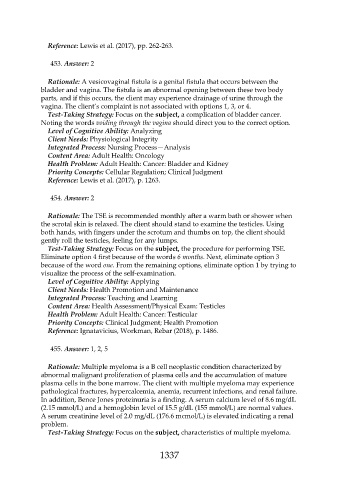Page 1337 - Saunders Comprehensive Review For NCLEX-RN
P. 1337
Reference: Lewis et al. (2017), pp. 262-263.
453. Answer: 2
Rationale: A vesicovaginal fistula is a genital fistula that occurs between the
bladder and vagina. The fistula is an abnormal opening between these two body
parts, and if this occurs, the client may experience drainage of urine through the
vagina. The client’s complaint is not associated with options 1, 3, or 4.
Test-Taking Strategy: Focus on the subject, a complication of bladder cancer.
Noting the words voiding through the vagina should direct you to the correct option.
Level of Cognitive Ability: Analyzing
Client Needs: Physiological Integrity
Integrated Process: Nursing Process—Analysis
Content Area: Adult Health: Oncology
Health Problem: Adult Health: Cancer: Bladder and Kidney
Priority Concepts: Cellular Regulation; Clinical Judgment
Reference: Lewis et al. (2017), p. 1263.
454. Answer: 2
Rationale: The TSE is recommended monthly after a warm bath or shower when
the scrotal skin is relaxed. The client should stand to examine the testicles. Using
both hands, with fingers under the scrotum and thumbs on top, the client should
gently roll the testicles, feeling for any lumps.
Test-Taking Strategy: Focus on the subject, the procedure for performing TSE.
Eliminate option 4 first because of the words 6 months. Next, eliminate option 3
because of the word one. From the remaining options, eliminate option 1 by trying to
visualize the process of the self-examination.
Level of Cognitive Ability: Applying
Client Needs: Health Promotion and Maintenance
Integrated Process: Teaching and Learning
Content Area: Health Assessment/Physical Exam: Testicles
Health Problem: Adult Health: Cancer: Testicular
Priority Concepts: Clinical Judgment; Health Promotion
Reference: Ignatavicius, Workman, Rebar (2018), p. 1486.
455. Answer: 1, 2, 5
Rationale: Multiple myeloma is a B cell neoplastic condition characterized by
abnormal malignant proliferation of plasma cells and the accumulation of mature
plasma cells in the bone marrow. The client with multiple myeloma may experience
pathological fractures, hypercalcemia, anemia, recurrent infections, and renal failure.
In addition, Bence Jones proteinuria is a finding. A serum calcium level of 8.6 mg/dL
(2.15 mmol/L) and a hemoglobin level of 15.5 g/dL (155 mmol/L) are normal values.
A serum creatinine level of 2.0 mg/dL (176.6 mcmol/L) is elevated indicating a renal
problem.
Test-Taking Strategy: Focus on the subject, characteristics of multiple myeloma.
1337

